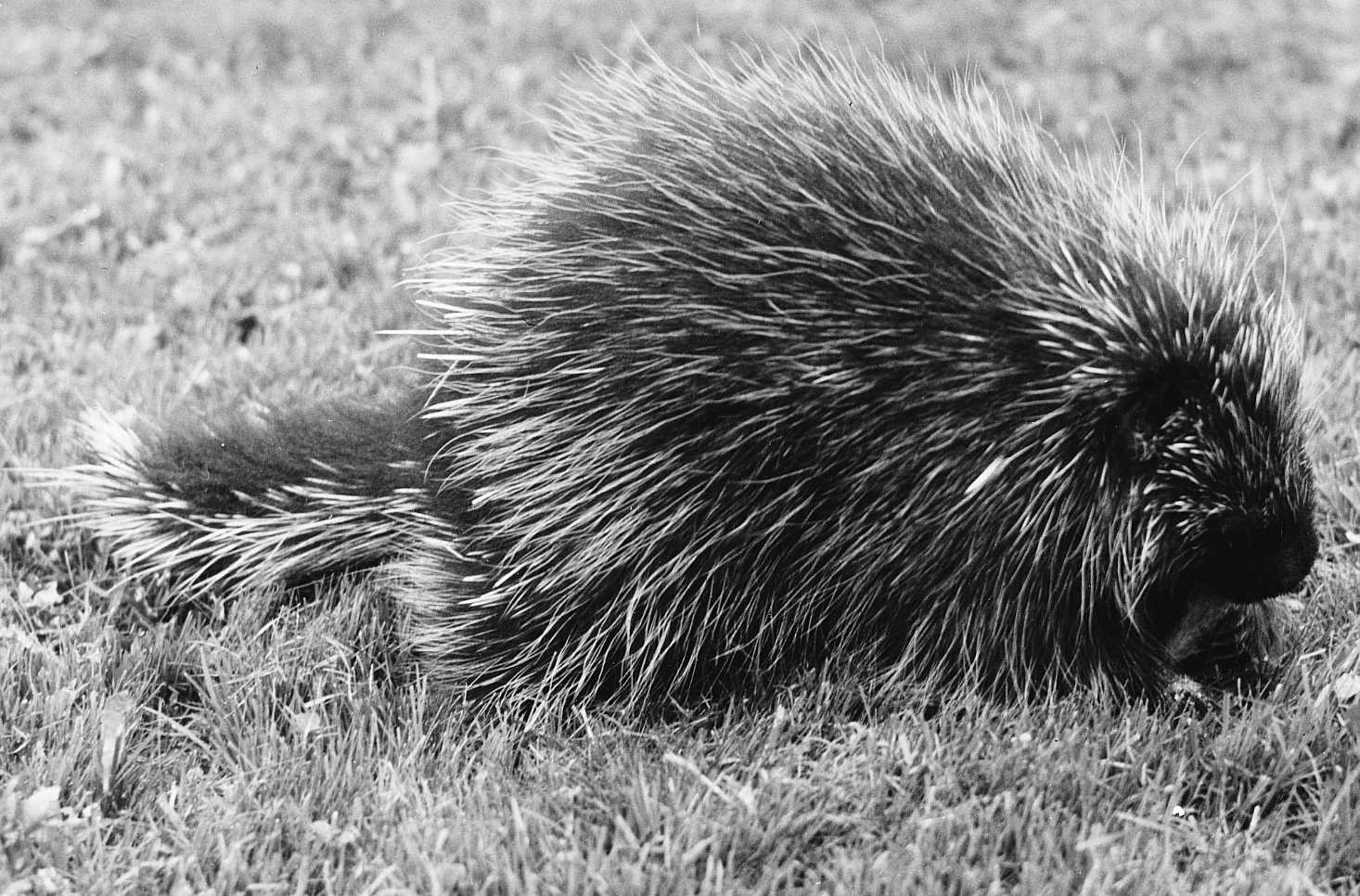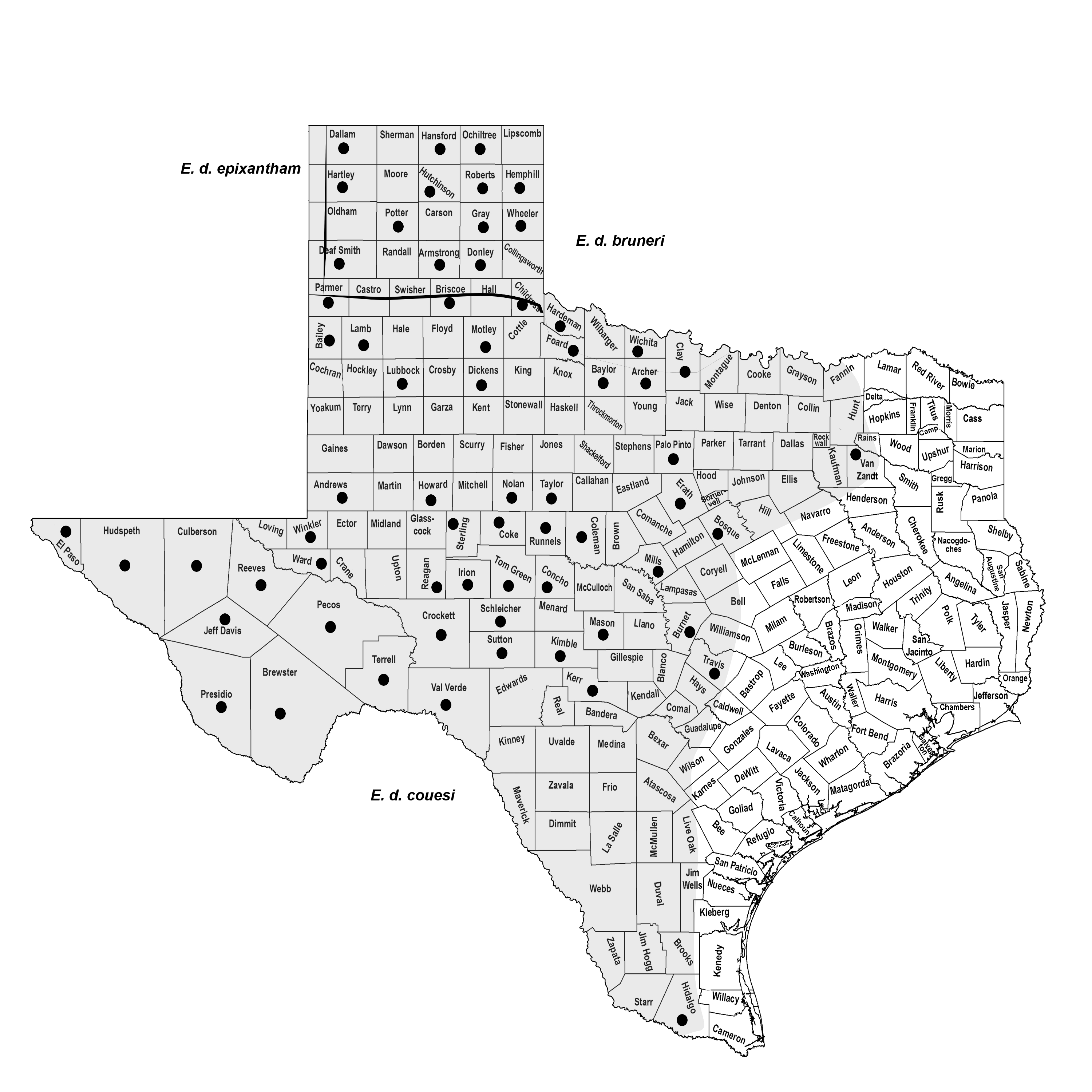NORTH AMERICAN PORCUPINE
Erethizon dorsatum (Linnaeus 1758)
Order Rodentia : Family Erethizontidae
DESCRIPTION. A large rodent with distinct barbed quills on back, sides, and tail; quills are yellowish white with a tip that varies from brown to black; overall coloration usually appears black or blackish. Dental formula: I 1/1, C 0/0, Pm 1/1, M 3/3 × 2 = 20. External measurements averages: males, total length, 808 mm; tail, 235 mm; hind foot, 98 mm; females, 737-230-81 mm. Weight, 5–11 kg.

DISTRIBUTION. Known from western half of state, east to Bosque, Travis, and Van Zandt Counties; an individual recently was recorded from Hidalgo County.

SUBSPECIES. Erethizon d. epixanthum in extreme western edge of the Panhandle; E. d. bruneri in the northern Panhandle; and E. d. couesi in the remainder of the state.
HABITS. The porcupine is adapted to a variety of habitats. It is largely an inhabitant of forested areas in the West and prefers rocky areas, ridges, and slopes. It is less common in flats, valleys, and gulches. On the Llano Estacado, porcupines are associated with rocky escarpment as well as the sand sage–shin oak association and short-grass prairie. On the Edwards Plateau porcupines have been found most commonly along streams and rivers and in brushy, upland juniper habitats. In recent years, they have expanded their range into southern Texas.
They are expert at climbing trees, although their movements are slow, methodical, and seemingly awkward. They apparently are aware of their limitations, and they take few chances while climbing. Porcupines seem to be as much at home in the rocks as on the ground or in trees. The more massive and broken the rocks, the better they serve the animals, for the numerous crevices and caves can be used as den sites and the large boulders as resting places. Where rocky dens are accessible, they are visited at intervals by many porcupines from the surrounding region and are used from year to year. Where such dens are unavailable, a hollow log, a windfall, or an upturned or loosened tree root system may be used.
In winter, when snow covers the ground, porcupines seldom travel far from their dens, especially in freezing weather. As warm weather approaches, the amount of travel increases.
Herbaceous ground vegetation makes up 85% of the food of both old and young in summer. In fall, only 27% of their food is herbaceous; 73% is tree gathered and includes mistletoe, the inner bark of a variety of trees, and pine needles. In winter, the food is wholly from trees, and pine needles and inner bark are consumed at their peak during this season. In spring, they again return to herbaceous ground vegetation, which then makes up nearly 40% of their diet. Throughout the year the porcupine is more of a browser than a grazer and subsists in large measure on the inner bark of trees and shrubs; grass is of no importance at any time of the year. Porcupines are especially fond of salt and are easily attracted to it, a trait that is useful in their control.
Breeding takes place in late summer and early fall, with the peak of activity in September and early October. The young, usually one, rarely two, are born about 7 months later in April and May. The gestation period is 209–217 days. At birth, the young porcupine weighs about 450 g and is larger than a newborn black bear. It is covered with a good coat of blackish hair, the quills are well developed, the eyes and ears are functional, and the incisors and some of the cheek teeth have erupted. Young are usually suckled for only a short period; they begin to feed on vegetation shortly after birth, and soon become entirely dependent on their own resources. The young porcupines grow slowly compared with most rodents, and females do not mature sexually until their second fall, when they weigh about 4 kg. Porcupines have a relatively long life span. One marked female is known to have lived over 10 years under natural conditions.
POPULATION STATUS. Uncommon to common. The North American porcupine represents another example of a mammal that has expanded its range in Texas during the twentieth century. Vernon Bailey, when he and his fellow agents worked in Texas at the end of the nineteenth century, recorded them only in one county in the Panhandle and in Jeff Davis and Brewster counties in the western part of the state. None of the early explorers or naturalists, until the report of Bailey, had documented the porcupine's occurrence in the state. Today, the species occurs east to Bosque County and appears to be expanding westward. In some areas, the porcupine is becoming more commonly encountered.
CONSERVATION STATUS. The IUCN lists the North American porcupine as a species of least concern, and it does not appear on the federal or state lists of concerned species. It does not appear to be under any immediate threat.
REMARKS. Porcupines often become problematic due to their diet. In many areas, porcupines cause major damage to orchards, landscape vegetation, and ornamental trees. In addition, interactions between porcupines and wildlife species including dogs, cattle, and horses may result in serious wounds and even death when the quills become lodged in the mouth, eyes, and nasal regions.
Michael Tewes (Texas A&M University–Kingsville) recently collected a porcupine in the Rio Grande Valley (Hidalgo County), indicating they may be expanding their range to the south.
From The Mammals of Texas, Seventh Edition by David J. Schmidly and Robert D. Bradley, copyright © 1994, 2004, 2016. Courtesy of the University of Texas Press.
Natural Science Research Laboratory
-
Address
Museum of Texas Tech University, 3301 4th street, Lubbock, TX 79409 -
Phone
806.742.2486 -
Email
nsrl.museum@ttu.edu

